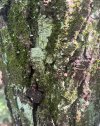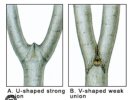TreeRecon
Well-Known Member
- Joined
- Sep 10, 2023
- Messages
- 272
Disclaimer: This is informational only and not a substitute for actual in-person training. Use these methods at your own risk. Climbing trees is dangerous and could injure or kill you if you're untrained.
Since this is a safety oriented forum, I decided to provide a few tips to those that may be interested.
Trees are living specimens and just like anything else, their viability can change over time. They are susceptible to diseases and environmental conditions. A tree or branch that was solid last season, could have experienced decay since you last used it.
Saddle hunters theoretically don't put a lot of strain on trees. So common sense is usually enough to choose a suitable tree. However, there are some situations where inner decay may be present in the tree, which could mean it could fail without warning
This is not an exhaustive list, but here are some tips that may be helpful:
1. When choosing a tree to hunt from, start by viewing it from a distance. Take note of its lean, canopy health (is there dieback?) and note any hangers or widow makers. Note that trees with crowns that look healthy, can still have inner decay. Don't skip the next steps.
2. Even though this is unlikely in the woods, look for overhead power lines. If any part of them touch the tree, find a different tree. If you hunt from a tree that happens to be near a power line, stay 10' away for voltages up to 72.5kV. Also look for insects or animals
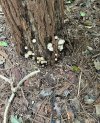
3. Walk up to the tree. Visibly examine the root structure. The buttress roots should be visible and free of decay. If you notice any upheaving, choose another tree. Examine the root structure for any fruiting bodies (decay). If the root structure isn't visible, you can remove dirt with your hands to examine them.
4. Start examining the base of the tree. Ensure there's appropriate flare. Again, look for the presence of fruiting bodies, missing or loose bark or any insect damage. Certain trees are more prone to infestation or certain insects (ex: Emerald Ash Borer).
5. Speaking of insects, if you see significant insect activity on the tree, choose another tree. Carpenter ants are a telltale sign the tree is under decay
6. Start looking more towards the crown. Look for any co-dominance (weak points), cracks, cankers or hangers. Look for unions and potential areas to tie into
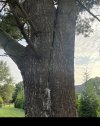
7. A note on unions: If you find a healthy union you plan on throwing your line into, ensure you're examining the structure below it too. Always tie into the branch collar (the area of the branch closest to the tree)
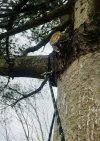
Final note: There are a few trees I'd be careful climbing, even if they appear healthy. Reason being is that you'll likely be far away from help. Those trees are: Bradford Pears and Tree of Heaven. I've known guys who have snapped large branches, simply from weight testing them. Don't forget to look around you for trees that could fail and injure you as well.
Since this is a safety oriented forum, I decided to provide a few tips to those that may be interested.
Trees are living specimens and just like anything else, their viability can change over time. They are susceptible to diseases and environmental conditions. A tree or branch that was solid last season, could have experienced decay since you last used it.
Saddle hunters theoretically don't put a lot of strain on trees. So common sense is usually enough to choose a suitable tree. However, there are some situations where inner decay may be present in the tree, which could mean it could fail without warning
This is not an exhaustive list, but here are some tips that may be helpful:
1. When choosing a tree to hunt from, start by viewing it from a distance. Take note of its lean, canopy health (is there dieback?) and note any hangers or widow makers. Note that trees with crowns that look healthy, can still have inner decay. Don't skip the next steps.
2. Even though this is unlikely in the woods, look for overhead power lines. If any part of them touch the tree, find a different tree. If you hunt from a tree that happens to be near a power line, stay 10' away for voltages up to 72.5kV. Also look for insects or animals

3. Walk up to the tree. Visibly examine the root structure. The buttress roots should be visible and free of decay. If you notice any upheaving, choose another tree. Examine the root structure for any fruiting bodies (decay). If the root structure isn't visible, you can remove dirt with your hands to examine them.
4. Start examining the base of the tree. Ensure there's appropriate flare. Again, look for the presence of fruiting bodies, missing or loose bark or any insect damage. Certain trees are more prone to infestation or certain insects (ex: Emerald Ash Borer).
5. Speaking of insects, if you see significant insect activity on the tree, choose another tree. Carpenter ants are a telltale sign the tree is under decay
6. Start looking more towards the crown. Look for any co-dominance (weak points), cracks, cankers or hangers. Look for unions and potential areas to tie into

7. A note on unions: If you find a healthy union you plan on throwing your line into, ensure you're examining the structure below it too. Always tie into the branch collar (the area of the branch closest to the tree)

Final note: There are a few trees I'd be careful climbing, even if they appear healthy. Reason being is that you'll likely be far away from help. Those trees are: Bradford Pears and Tree of Heaven. I've known guys who have snapped large branches, simply from weight testing them. Don't forget to look around you for trees that could fail and injure you as well.
Last edited:


